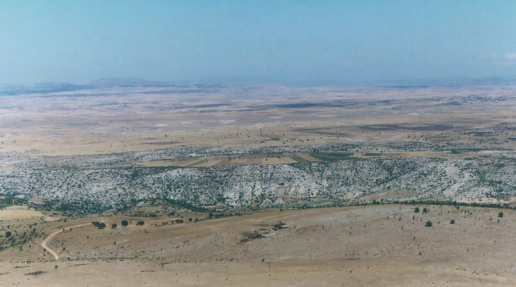Clik here to view.

The Banazova Plateau, site of the New Jerusalem
The prophet drew opinions the way a sweaty horse draws flies. Some reverenced him as God’s sainted mouthpiece, while others called him heretic, madman, and scoundrel. Critics charged that he added to the Bible, denied the Trinity, and generally had the odor of the devil about him.
Mad he may have been, but people craved his sort of madness. He reintroduced prophetic authority to a Christian world out of touch with apostolic power. Spurned by traditional churches, he established his own and appointed two other prophets to help lead it. Together, the three dictated new scriptures in the divine first person and canonized them alongside the Bible.
Restorers rather than innovators, the Three placed themselves in a line of prophetic succession dating back to New Testament prophets. First in line stood Agabus (Acts 11:28), then Judas and Silas (Acts 15:32), then the daughters of Philip (Acts 21:9). Next came Quadratus and Ammia, whose deaths interrupted the succession. In the revelations to the Three—Montanus, Priscilla, and Maximilla—the line was renewed. And yes: like Philip’s daughters before them, Priscilla and Maximilla were female. Even the eunuch Montanus lacked a certain male quality.
Founded in west-central Turkey in the second century CE, the New Prophecy soon made converts across the known world. Like another prophet sixteen centuries later, Montanus revealed the location of the New Jerusalem and urged his followers to “gather” there. Disciples flocked to the towns of Tymion and Pepuza, situated at opposite edges of the Banazova plateau. This vast, level plain seemed a perfect landing site for the New Jerusalem, a holy city described in Revelation as “coming down from God out of heaven” (Rev. 21:2). Though the site doesn’t exactly look like paradise, Montanist architecture made generous use of the region’s abundant white marble to compensate for its desolate ecology.
Clik here to view.

This rock-cut monastery near Pepuza may date to the Montanist period
Initially Montanus may not have set out to found a new church. His early followers remained within the traditional churches as a special cadre of prophecy-believers. But it didn’t take long for orthodox bishops to oppose and expel them, declaring their baptisms invalid. Descending on Pepuza like Baptist street preachers on General Conference, bishops preached against the movement and tried to cast devils from its prophets.
Not opposed to prophecy in principle, the bishops protested mainly the Montanist mode of prophesying in a trance. As the divine voice explained it through Montanus, “man is like a lyre, and I dart like the plectrum. The man sleeps, and I am awake.” Such Holy Spirit possession smacked too much of the demonic for orthodox tastes. Biblical examples suggested prophets should stay in control of their faculties when prophesying.
Gender prejudice also played a role in the opposition. Two of the three original prophets were women, and a prophetess named Quintilla headed the movement in a subsequent generation. “They magnify those weak females above the apostles,” Hippolytus griped. Montanists also ordained women as bishops and elders (Latin presbyterī, etymological ancestor of “priest”). Sounding like a modern anti-feminist, Epiphanius complained that they taught “there is no difference” between the genders. Although critics didn’t always address gender issues directly, many coded their critiques of Montanist prophesying in subtly gendered language.
Montanists fought this prejudice with biblical prooftexts. In addition to the example of Philip’s daughters, they also cited the Israelite judge Deborah, the promise of Acts that “your sons and daughters will prophesy,” Paul’s statement that in Christ Jesus “there is neither male nor female,” and Paul’s rule (which Montanists strictly obeyed) that prophetesses must wear a veil (Judg. 4:4; Acts 2:17; Gal. 3:28; 1 Cor. 11:5).
To these prooftexts the prophetesses added new ones of their own. Quintilla, in particular, reported a remarkable vision in which Christ “assumed the form of a woman . . . came to me in a bright robe and put Wisdom in me.” Quintilla also taught a “fortunate Fall”: that Eve did not sin when she ate of the tree of knowledge, but rather became the first to receive Wisdom. Mormons may be unfamiliar with Wisdom—an ancient feminine image of God and the pre-existent Christ—but Quintilla’s teaching on the Fall should ring some bells.
Clik here to view.

Perpetua and Felicitas, famous Montanist martyrs
Unfortunately, opposition to the New Prophecy took a sinister turn in the time of the emperor Constantine, who ordered their buildings seized and their books burned. Not to be outdone, sixth-century emperor Justinian dispatched an army to Tymion and Pepuza with orders to convert the Montanists at swordpoint. Some besieged disciples locked themselves in a church and set it on fire rather than surrender. Their deaths offered morbid but compelling testimony to the force of their faith. A repeat of this episode in the eighth century marks the last mention of Montanists in the historical record.
Was the New Prophecy a precursor to the Mormon message? If so, what can be learned from its teachings on gender? Or were the Three as mad as their critics claimed? Is the movement’s tragic end a cautionary tale about obedience to prophetic authority? Questions like these are well worth asking, even if the answers are unknowable.
But in the end, perhaps this isn’t a morality tale. Perhaps the point is just to recognize kindred spirits across the chasm of time and to gather the remnants of their stories. Perhaps it’s enough to just remember.
References
Tabbernee, William. Montanist Inscriptions and Testimonia: Epigraphic Sources Illustrating the History of Montanism, vol. 16 of the Patristic Monograph Series. Macon, Ga.: Mercer University Press, 1997.
Tabbernee, William, and Peter Lampe. Pepouza and Tymion: The Discovery and Archaeological Exploration of a Lost Ancient City and an Imperial Estate. Berlin: Walter de Gruyter, 2008.
Trevett, Christine. Montanism: Gender, Authority and the New Prophecy. Cambridge University Press, 1996.